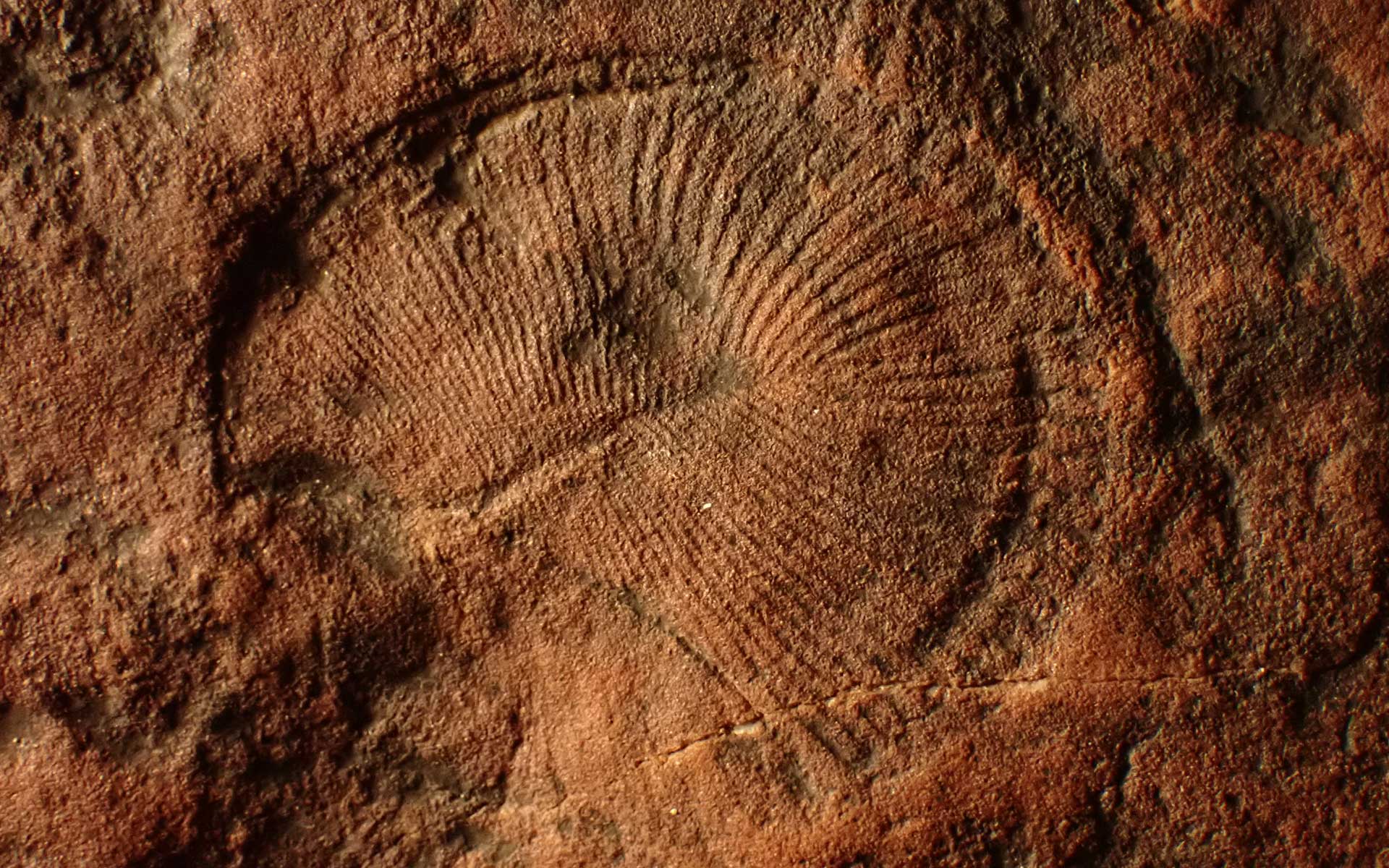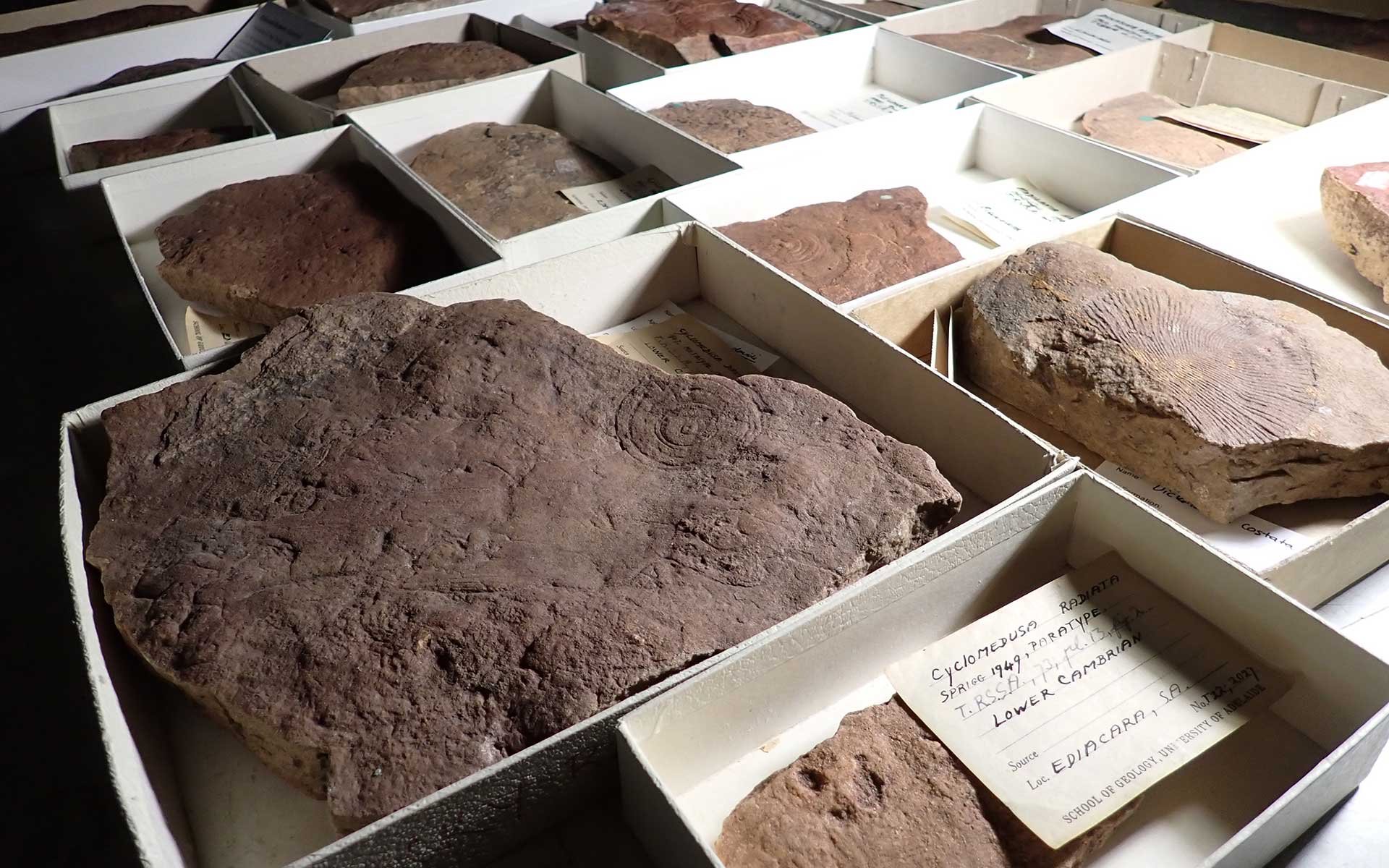Sprigg Ediacaran Fossil Collection, South Australian Museum-Adelaide Palaeontological Collections
Australia

Holotype of one of the characteristic fossils of the Ediacara biota: Dickinsonia costata originally illustrated by Sprigg 1947, pl. 7, fig. 2. Length of specimen 68mm.
Housing institution
South Australian Museum – Adelaide (SAMA)
Location
The Science Centre building, North Terrace, Adelaide, South Australia 5000
34° 55’ 9” S, 138° 36’ 7” E
Homepage
Holotype of one of the characteristic fossils of the Ediacara biota: Dickinsonia costata originally illustrated by Sprigg 1947, pl. 7, fig. 2. Length of specimen 68mm.
The Sprigg collection contains the original material of the Ediacaran biota collected by Reg Sprigg in 1946 and later years.
- Geo-collection description
The Sprigg collection comprises about 100 fossils of Ediacaran age, as first collected by Reginald Claude Sprigg from the Ediacaran Hills, about 30 kilometres west of Beltana in the Flinders Ranges, South Australia. Sprigg discovered the fossils in 1946, near the old Ediacara mine site, as part of his work with the Geological Survey of South Australia. After further collecting, Sprigg produced three papers describing the fossils (Sprigg 1947, 1949), two of which were in the Transactions of the Royal Society of South Australia and the other one in Nature. Taxa described included the iconic Dickinsonia costata. Sprigg recognized that the stratigraphic position of the Ediacara fauna, within the Pound Quartzite (now the Rawnsley Quartzite), indicated they were considerably older than previously documented fossils such as archaeocyatha, trilobites and brachiopods previously found in Cambrian rocks of the Flinders Ranges. Sprigg suggested a very early Cambrian age, and it was not until the late 1950s that their late Precambrian age was recognized. At the time it was considered that metazoan fossils, such as those from Ediacara clearly were, did not occur in rocks older than the Cambrian.
- Geo-collection value
The Sprigg Collection is extremely significant in that it represents the first discovery of an assemblage of multicellular biota from rocks of what is now termed the Ediacaran period. The Ediacaran Biota, from the Flinders Ranges and elsewhere, represents the early stages of metazoan evolution with the fossils being quite different from the fossil assemblages of the overlying Cambrian rocks. The fossils from Ediacara and elsewhere in the Flinders Ranges led in 2004 to the establishment of the GSSP for the Ediacaran period in Enorama Creek in the Flinders Ranges. The Ediacaran was the first new internationally recognized geological period to be established in over 120 years and the first in the southern hemisphere. The initial discovery at Ediacara led to the finding of numerous other fossil localities at a similar stratigraphic level elsewhere in the Flinders Ranges (Gehling & Vickers-Rich 2007, Droser et al., 2020, Runnegar 2021). Although early descriptions were done with material from Ediacara, in the last twenty years work has been concentrated at Nilpena, 15 kilometres south of Ediacara. This has led to the establishment of the Nilpena Ediacara National Park with an interpretive centre at Nilpena.
- Reference
- Sprigg, R.C., 1947. Early Cambrian (?) jellyfishes from the Flinders Ranges, South Australia. Transactions of the Royal Society of South Australia 71, 212-228.
- Sprigg, R.C., 1949. Early Cambrian “jellyfishes” of Ediacara, South Australia and Mount John, Kimberley District, Western Australia. Transactions of the Royal Society of South Australia 73, 72-112.
- Gehling, J.G. & Vickers-Rich, P., 2007.The Ediacara Hills. 89-113 in Fedonkin, M.A., Gehling, J.G., Grey, K., Narbonne, G.M. & Vickers-Rich, P. The Rise of Animals. The Johns Hopkins University Press, Baltimore, 326p.
- Droser, M.L., Tarhan, L.G., Evans, S.D., Surprenant, R.L. & Gehling, J.G., 2020. Biostratinomy of the Ediacara Member (Rawnsley Quartzite, South Australia): implications for depositional environment, ecology and biology of Ediacaran organisms. Interface Focus 10: 20190100.
- Runnegar, B., 2021. Following the logic behind biological interpretations of the Ediacara biotas. Geological Magazine 159, 1093-1117.

